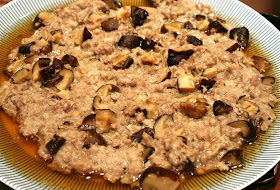I've finally got most of my backlogged posts published. Which considering the last two months was no easy feat. I never mentioned it before, but I was out of the country during the last two weeks of January and traveled back home to Perth to be with my extended family during Chinese New Year. Then I ended up scheduled to work every weekend since I was back in Sydney until now. I actually got most of my posts finished up last weekend, when I was working onsite. I had to wait for the other teams to finish before I had to do my part. That wait took 5 hours. Most data centers are like a large and very noisy walk-in refrigerator. This one was one of those. All I could think of while waiting (and typing up my posts), was that I wish I had a nice hot bowl of miso soup with me.
In that environment, I don't think there could be anything that could be as soul satisfying than sitting there with my hands cupped around a hot bowl of miso soup, sipping away, savouring each mouthful.
And you guessed it, as soon as my part was done, I got home, boiled some water, added some dashi granules, miso paste and some other ingredients found in my pantry and fridge and 10 mins later... ta-daaa.. Miso Soup...!
Miso is a great base for a seafood based soup too. Whenever I do have enough seafood bits and pieces on hand (and the spare time), I make a Fisherman's Soup with the off cuts of seafood (eg. Fish head, Mussels, salmon, prawn) with miso. But this time, it was just a simple miso soup with some Enoki mushrooms thrown in... And boy did it hit the spot. :)
Miso Soup - Miso Shiru
normally serves 2, or 1 in this case (if you want seconds)
- 1 teaspoon Dashi granules
- 3 cups water
- 2 tablespoons White miso paste *
- 1/2 tablespoon Mirin
- 1 piece package Silken tofu (diced into cubes - 1 piece is about 75g)
- 1 tablespoon Wakame seaweed
- 70g Enoki Mushroom (washed, brown roots removed) - Optional
* you may need to adjust this depending on the type of miso used
Method:
- In a medium saucepan over medium-high heat, add in the dashi granules to the water and bring to a boil.
- Reduce heat to medium, pour in the mirin and whisk in the miso paste.
- Add in the Enoki mushrooms and seaweed.
- Stir in the tofu cubes.
- Simmer gently for 2 to 3 minutes before serving.
.jpg)


.jpg)
.jpg)
.jpg)
.jpg)
.jpg)
.jpg)
.jpg)
.jpg)
.jpg)
.jpg)